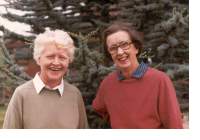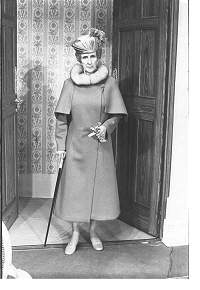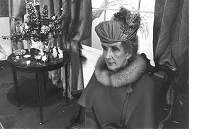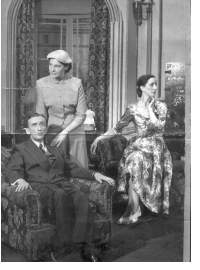| |
The first in an occasional series of articles
about Barford people, past and present. |
|
JOYCE WILLSON (a Tribute from Betty Corbridge)
Joyce
was born (and Christened Joyce Mary Willson) on 9th August 1915
in a house on Clapton Common in London. In those days cows were
to be seen on the Common and the First World War was three years
away
from ending.
She was the only child of both her parents’ second marriages
and she had a stepbrother (Jack) and two step sisters. Although
she did not herself marry, she had numerous nieces and nephews all
of
whom adored her because she was the best of “Aunts” to
them all. She was closest to her step brother’s children as
she lived nearest to them in North London so they were the lucky
recipients on birthdays and at Christmas of presents – games,
dolls, dolls’ houses,
toy theatres, fancy dresses – everything hand made by “Auntie
Joyce”. She made a beautiful doll’s house, including furniture
for every room, for one of her nieces, complete in every detail – or
so she thought – until her niece informed her that she was a
bit disappointed because the lavatory didn’t flush!
Her nephew
John is today the artist who was commissioned to paint the Royal Family
on the occasion of the Queens Mother’s Centenary.
Joyce was very proud of John’s achievements and she had many
personal examples of his work as John
Wonnacott the distinguished
artist.
 |
Betty Corbridge (left) and Joyce Willson
|
Joyce went to school at St. Bernard’s Convent,
Southend in Essex. At that time her Mother and Father were living
in a hotel
as
her Mother was not at all strong with heart trouble but I think
she enjoyed this period of her life. Hotel life could be great fun
in
the twenties and early thirties with plenty of social activities
and she certainly enjoyed her school days. She did extremely well academically
and at school her potential as an artist and also as a talented
actress
was realised. I think the nuns were slightly amazed at the suits
of armour (and many other costumes) she produced for the classical
plays
in which she appeared during her school days.
Joyce started her working
career in the gown trade at what was then a well known store – Debenham and Freebody. For this period
of her working life she worked as a mannéquin and as she was
tall, slim and elegant she was well suited to display beautiful and
very valuable furs. Eventually she left the retail gown trade and
worked in a wholesale dress firm but at one time she designed and
made costumes for the professional theatre. The names of the actresses
she dressed are probably not known today although a leading actor
in one play – Max Adrian – was very kind to her when,
dashing around back stage, she nearly knocked herself out on a
piece of scenery.
 |
Finally, for the last
ten to twelve years of her working life she left the fashion
world and joined the academic world as an administrative assistant
in an organisation concerned with higher education where I
was also employed. She made a great success of the final part
of her career working mainly on statistics.
Throughout the war Joyce lived in North London
(Muswell Hill) and nursed her Mother and Father who both became
ill and for this reason she was not able to join the forces
nor was she free to indulge in her love of the theatre or
to take part in acting herself. However, in 1946, both her
parents having died, she was free to offer her services to
a local drama group of which I was a member and so we met
for the first time and formed a friendship which was to last,
unbroken, until her death two years ago. |
As Queen Mary in "Crown Matrimonial" |
Our mutual passion for the theatre was
the foundation for this rare friendship together with (as a great
friend
once said) an admiration for each other’s talents. After her
parents died Joyce lived in a hotel in Muswell Hill and then
came to live with me and my Mother and sister.
 |
In "Crown Matrimonial"
|
From then on Joyce’s talents and charming personality were
revealed to us all. When she joined us in 1946 we were in rehearsal
for a Noel Coward play ‘This Happy Breed’ – a play
covering a period from 1919 to 1939 requiring a change of costume
for 12 actors in 9 different scenes. Joyce modestly suggested she
might be able to help with the costumes and then proceeded to produce
over 50 costumes entirely by herself working in one small bedroom
in a hotel from any material she could find (rationing was still in
force). Thanks to her the play was a great success.
In the same year
she played her first part for the company and thereafter displayed
her wonderful talent as an actress in over sixty roles until the company’s
final production of Noel Coward’s ‘Hay Fever’ in
1984.
As well as acting she designed and made the most beautiful costumes
for such productions as “Mary Stewart”, “Pride and
Prejudice”, “Tom Jones”, “Vivat Vivat Regina” – the
list is endless and I think many people here in Barford will have
seen in our plays some of the amazing props she made. She was a lovely
actress able to play a wide variety of parts and amongst some of her
outstanding performances were Queen Mary in “Crown Matrimonial”,
Mrs St. Maughan in Enid Bagnold’s “The Chalk Garden” a
hilarious performance as Emma Hornett in “Sailor Beware” and
her final performance in London as Judith Bliss in Noel Coward’s “Hay
Fever”. She had a great gift of comedy as many will know who
saw her perform in the Music Hall and I hope Nut and Bolt will
not be forgotten.
 |
In "The Constant Wife",
1954
|
Such a talented lady you might think should be entitled
to a little feeling of pride in some of her achievements but she
had none. She
was the quietest most self-effacing and modest person you could
meet. She was never convinced that anything she did was particularly
good – certainly
not brilliant – she just loved being part of the world of theatre
whether playing a part or designing a set or a costume or making a
piece of furniture or perhaps best of all – making people laugh.
She never entertained the idea of using any of her talents in a
professional way but, of course, when we lived in London our greatest
pleasure
was to see all the best professional productions and to visit the
RSC at Stratford and the theatre at Chichester.
Joyce was a unique
person, rarely having a bad word for anybody – not
a Church-goer but one whose faith was unshakeable.
She was intelligent,
she was fun - she couldn’t spell and she wasn’t any good
at tennis. I checked all her spelling and I was very good at tennis.
She could paint beautifully and produce exquisite wood carvings. I
am useless doing anything with my hands and our taste in literature
was entirely different.
We were opposite in so many ways but so completely
as one in so many others that we slotted together like two pieces
in a jig saw. The years we spent together couldn’t have been
more rewarding, more fun or more wonderful. When Joyce joined our
drama company in London our Chairman said to me ‘Joyce is a
lady’; and so she was – a lovely lady remembered by so
many with deep affection.
Betty Corbridge
September 2004
[Back to top]
|
|

